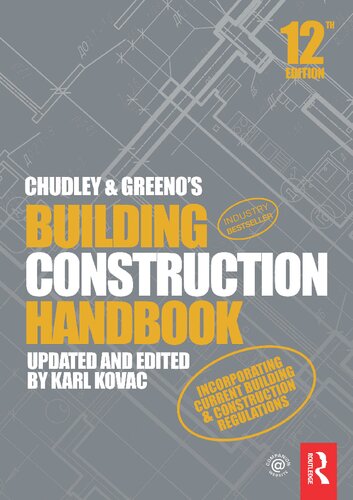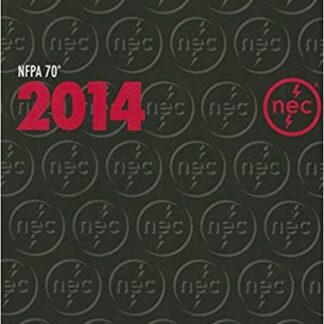Description
Chudley and Greeno’s Building Construction Handbook 12th Edition by Roy Chudley, ISBN-13: 978-0367135423
[PDF eBook eTextbook]
- Publisher: Routledge; 12th edition (March 31, 2020)
- Language: English
- 742 pages
- ISBN-10: 0367135426
- ISBN-13: 978-0367135423
The 12th edition of Chudley and Greeno’s Building Construction Handbook remains THE authoritative reference for all construction students and professionals. The principles and processes of construction are explained with the concepts of design included where appropriate. Extensive coverage of building construction practice, techniques and regulations representing both traditional procedures and modern developments are included to provide the most comprehensive and easy to understand guide to building construction.
Table of Contents:
Cover
Half Title
Title Page
Copyright Page
Contents
List of figures
List of tables
Preface
1 Pre-construction
1.1 Design considerations
1.2 Modular coordination
1.3 Construction contract documents
1.4 Planning legislation
1.5 Building control
1.6 Health and Safety
1.7 Building organisations
1.8 Building Information Modelling (BIM)
1.9 Building information classification systems
2 Site investigation
2.1 Desk study
2.2 Field study
2.3 Site survey and ground investigation
2.4 Soil analysis
2.5 Site soil testing techniques
3 Site works
3.1 General considerations
3.2 Setting out
3.3 Levelling
3.4 Road and paving
3.5 Landscaping
3.6 Personal protective equipment (PPE)
3.7 Demolition
4 Soil improvement and excavation
4.1 Vibro replacement
4.2 Vibro compaction
4.3 Dynamic compaction
4.4 Jet grouting
4.5 Excavation support
4.6 Cofferdams
4.7 Steel sheet piling
4.8 Caissons
4.9 Culverts
4.10 Dewatering
4.11 Contaminated land
4.12 Retaining walls
5 Materials
5.1 Density of building materials
5.2 Concrete
5.3 Timber
5.4 Joinery production
5.5 Composite boards
5.6 Plasters and plasterboards
5.7 Plastics
5.8 Mastics and sealants
5.9 Metals
6 Plant
6.1 Earthmoving
6.2 Material handling
6.3 Scaffolds
7 Foundations
7.1 Trees
7.2 Foundation design
7.3 Strip foundations
7.4 Raft foundations
7.5 Pad foundations
7.6 Small diameter piles and ground beams
7.7 Pile foundations
8 Basement construction
8.1 Secant pile walls
8.2 Diaphragm walls
8.3 Top down basement construction
8.4 Waterproofing basements
8.5 Basement insulation
9 Ground supported floors
9.1 Ground supported concrete floors
9.2 Industrial concrete floors
9.3 Concrete floor screeds
9.4 Resistance to contaminants
9.5 Ground floor insulation
9.6 Ground-bearing concrete
9.7 Suspended beam and block
9.8 Suspended timber
9.9 Thermal bridging ground floors
10 Suspended floors
10.1 Suspended timber ground floors
10.2 Beam and block floors
10.3 Timber upper floors
10.4 In-situ reinforced concrete floors
10.5 Precast concrete floors
10.6 Composite floors
10.7 Raised access flooring
11 External walls
11.1 Stone walls
11.2 Bricks
11.3 Blocks
11.4 Cement mortars
11.5 Damp proof courses (DPC)
11.6 Solid brick walls
11.7 Design of masonry walls
11.8 Jointing and pointing
11.9 Feature brickwork
11.10 Cavity wall construction
11.11 Cavity wall insulation
11.12 Thermal improvements
11.13 Thermal or cold bridging
11.14 Lintels and arches
11.15 Timber frame construction
11.16 Rendering
11.17 Claddings
12 Pitched roofs classification
12.1 Structure
12.2 Stability
12.3 Underlays
12.4 Double lap tiles
12.5 Single lap tiles
12.6 Ridges and hips
12.7 Slates
12.8 Fibre cement slates
12.9 Roof ventilation
12.10 Roof insulation
12.11 Vapour control layer (VCL)
12.12 Structural insulated panels (SIPs)
12.13 Thatched roofs
12.14 Steel roof trusses
12.15 Double skin, energy roof systems
12.16 Long span roofs
12.17 Membrane roof
12.18 Fabric
12.19 Rooflights
13 Flat roofs
13.1 Falls
13.2 Decks
13.3 Built up felt roofing (BUFR)
13.4 Mastic asphalt
13.5 Milled lead sheet
13.6 Single ply membranes
13.7 Glass reinforced plastic (GRP)
13.8 Green roofs
13.9 Flat roof insulation
13.10 Rooflights
14 Steel framed buildings
14.1 Development
14.2 Steel frame structure
14.3 Hot rolled steel sections
14.4 Steelwork connections
14.5 Fire protection
15 Concrete framed buildings
15.1 Formwork
15.2 Reinforcement
15.3 Structure
15.4 Fire protection
15.5 Precast concrete frames
15.6 Connections
15.7 Pre-stressed concrete
15.8 Pre-tensioning
15.9 Post-tensioning
15.10 Comparison of pre-stressed and reinforced concrete
15.11 Portal frames
16 Cladding of framed buildings
16.1 Non-load-bearing brick panels
16.2 Lightweight infill panels
16.3 Rainscreen cladding
16.4 Glazing
16.5 Structural glazing
16.6 Curtain walling
16.7 Concrete cladding panels
17 Windows and doors
17.1 Casement windows
17.2 Sliding sash windows
17.3 Pivot windows
17.4 Bay windows
17.5 Security
17.6 Window schedules
17.7 Glazing
17.8 Double glazing
17.9 Triple glazing
17.10 Glazing health and safety
17.11 External doors
17.12 Internal doors
17.13 Fire doors
18 Internal elements: Ceilings
18.1 Plasterboard ceilings
18.2 Suspended ceilings
18.3 Internal walls/partitions
18.4 Party walls
18.5 Stud partition walls
18.6 Demountable partitions
18.7 Solid plastering
18.8 Dry lining
18.9 Stairs
18.10 Paints and painting
18.11 Glazed wall tiling
19 Drainage
19.1 Below ground drainage – drains and sewers
19.2 Means of access
19.3 Drainage pipes
19.4 Surface water drainage
19.5 Sustainable urban drainage systems (SUDS)
19.6 Above ground drainage
19.7 Sanitary fittings
20 Building services
20.1 Cold water supply
20.2 Domestic hot water systems (DHW)
20.3 Space heating
20.4 Electrical services
20.5 Power circuits
20.6 Lighting circuits
20.7 Telecommunication services and electronic installations
20.8 Gas services
20.9 Flues
21 Insulation and U-values
21.1 U-values
21.2 Thermal conductivity (λ) of typical building materials
21.3 Floor insulation
21.4 Thermal bridging
21.5 Sound insulation
21.6 Sound insulation improvements
22 Construction defects
22.1 Building survey
22.2 Cracking in walls
22.3 Underpinning
22.4 Timber rot
22.5 Damp proof course remedial work
Index
Karl Kovac is a senior lecturer in Construction and Built Environment at Sheffield Hallam University, as well as Joint Course Leader for BSc Construction Project Management. He has worked at all levels of the construction industry, starting out as a general builder before becoming a building surveyor and project manager in both public and private sectors. He has taught at both Further and Higher Education levels on HNC, HND and BSc Built Environment and Construction programmes, as well as MSc programmes.
Roger Greeno has extensive practical and consultancy experience in the construction industry, in addition to lecturing at several colleges of further and higher education, and the University of Portsmouth, UK. He has also examined for City & Guilds, Edexcel, the Chartered Institute of Building and the University of Reading, UK.
Roy Chudley was formerly Senior Lecturer in Building Technology at the Guildford College of Technology, UK. He is an established author of numerous respected construction texts.
What makes us different?
• Instant Download
• Always Competitive Pricing
• 100% Privacy
• FREE Sample Available
• 24-7 LIVE Customer Support






